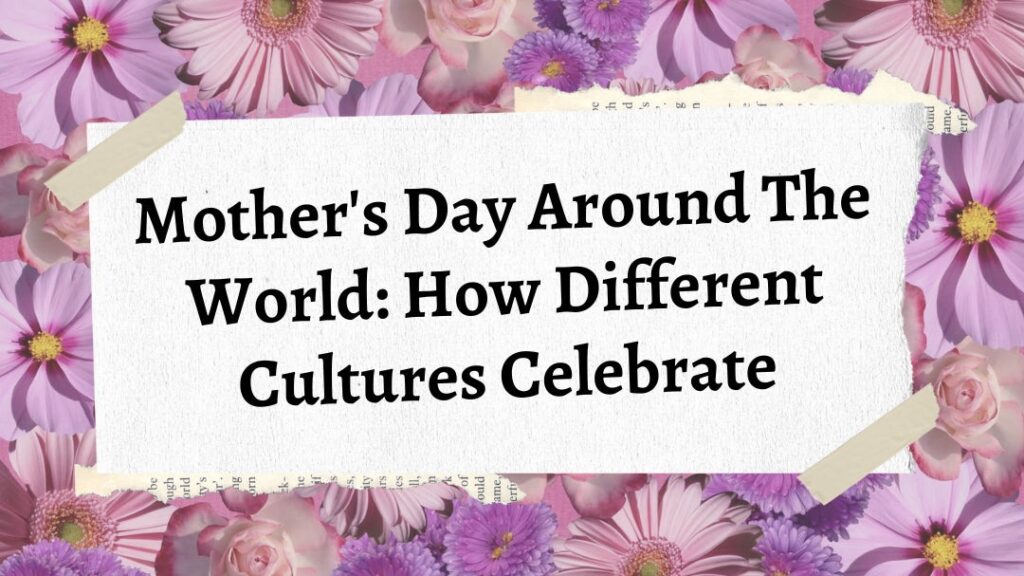Uncategorized
Mother’s Day Around the World: How Different Cultures Celebrate
Introduction
While many of us are familiar with celebrating Mother’s Day on the second Sunday in May with flowers, cards, and breakfast in bed, this special day dedicated to honoring maternal figures takes on fascinating and diverse forms around the world. From different dates to unique customs, the ways in which cultures celebrate motherhood reflect deep cultural values and traditions that have evolved over generations.
In this article, we’ll take a journey across continents to explore how Mother’s Day is celebrated globally, highlighting the rich tapestry of customs that all share one common thread: expressing gratitude and love for mothers.
North America
United States and Canada
In the United States and Canada, Mother’s Day falls on the second Sunday in May. The modern American Mother’s Day was established by Anna Jarvis in the early 20th century as a way to honor her own mother. Today, it typically involves:
- Giving cards, flowers (particularly carnations), and gifts
- Taking mom out for a special meal or preparing breakfast in bed
- Phone calls to mothers who live far away
- Family gatherings and special church services
Interestingly, Jarvis later grew disillusioned with the commercialization of the holiday she worked so hard to establish.

Mexico
Día de las Madres is celebrated on May 10th regardless of the day of the week. This celebration is marked by:
- A traditional morning serenade to mothers with the song “Las Mañanitas”
- Special church masses featuring the hymn “Himno a la Madre”
- School performances where children perform songs and skits for their mothers
- Lavish family meals, often featuring traditional dishes like mole and tamales

Europe
United Kingdom and Ireland
The UK and Ireland celebrate Mothering Sunday on the fourth Sunday of Lent, about three weeks before Easter. Originally a religious observance when people would return to their “mother church,” it evolved to include:
- Children presenting wild flowers gathered on the way home from church
- Traditional Simnel cake, a light fruit cake with marzipan
- Cards and gifts, similar to American traditions
- Family lunches, often featuring a traditional Sunday roast

Asia
Japan
Japan celebrates Haha no Hi on the second Sunday in May. This celebration is characterized by:
- Children drawing pictures of their mothers in school and gifting them
- Presenting red carnations or roses, which symbolize strength and endurance
- Preparing and serving mother’s favorite foods
- Giving thoughtful gifts like purses, scarves, or jewelry

India
While the Western Mother’s Day is increasingly celebrated in urban areas, India has its own tradition called Durga Puja, a 10-day festival celebrating the Divine Mother. Modern Mother’s Day celebrations include:
- Taking mothers out for meals at restaurants
- Buying thoughtful gifts
- Phone calls and visits to family
- Special events at schools honoring mothers

Africa
Ethiopia
Ethiopia has one of the most unique Mother’s Day celebrations called Antrosht, which occurs at the end of the rainy season in fall. This multi-day celebration includes:
- Children returning home to their mothers bringing ingredients for a special meal
- Traditional hash recipe prepared with various spices
- Daughters providing butter and vegetables, while sons bring meat
- Elaborate meals accompanied by singing and dancing that can last for several days
South Africa
South Africa celebrates Mother’s Day on the second Sunday in May, similar to the American tradition. Celebrations include:
- Wearing flowers: a red carnation for a living mother or a white carnation for a deceased mother
- Family gatherings with traditional South African braai (barbecue)
- Children performing acts of service for their mothers
- Special church services honoring mothers

South America
Brazil
Brazil celebrates Dia das Mães on the second Sunday of May with elaborate celebrations:
- Large multi-generational family gatherings
- Special church services followed by large Brazilian barbecues
- Children’s performances at schools
- The day is considered the second most commercial holiday after Christmas

Argentina
Argentina celebrates Día de la Madre on the third Sunday in October. This day is marked by:
- Family reunions with traditional asados (barbecues)
- Children preparing handmade presents at school
- Flowers and cards given as gifts
- A significant day for retail sales, second only to Christmas
Oceania
Australia
Australia celebrates Mother’s Day on the second Sunday in May with traditions including:
- Chrysanthemums are the flower of choice as they naturally bloom during Australian autumn
- The wearing of carnations: colored for living mothers, white for those who have passed
- Breakfast in bed or family brunches
- Community events honoring outstanding mothers

New Zealand
New Zealand also celebrates on the second Sunday in May with traditions similar to Australia, including:
- Giving cards and gifts, particularly handmade crafts from children
- Family meals, often breakfast in bed or brunches
- Community events honoring mothers
- Traditional Māori celebrations incorporating elements honoring maternal ancestors

The Role of Technology in Modern Mother’s Day Celebrations
In today’s interconnected world, technology has transformed how we celebrate Mother’s Day globally:
- Video calls allow families separated by distance to connect visually
- Social media platforms enable public expressions of gratitude
- Online gift ordering makes international gift-giving easier
- Digital cards and messages complement traditional paper ones
Conclusion
Mother’s Day celebrations around the world, while varied in their expressions and timing, all share the universal desire to honor and appreciate the women who nurture us. From the flower markets of Mexico City to the family gatherings in Ethiopia, these traditions highlight the cultural importance placed on motherhood across the globe.
No matter how different the customs may be, the sentiment remains the same: to express love, gratitude, and respect for the mothers who have shaped our lives. As we celebrate Mother’s Day in our own ways, we participate in a beautiful global tradition that transcends cultural boundaries.

